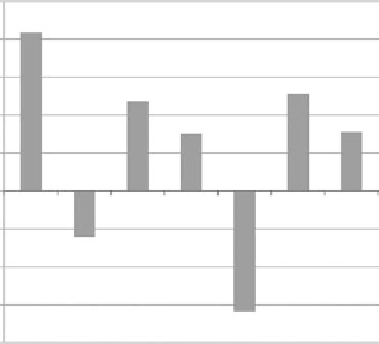Environmental Engineering Reference
In-Depth Information
Farm equipment
production
1.8%
Farm equipment
recycling
-0.5%
Fertilizer
production
6.1%
Fossil fuel use in
farming
operations
82.8%
Transport of
farm chemicals
9.3%
FIGure 11.24
Poplar agricultural production energy distribution. (From Mann, M.K. and Spath, P.L.,
Life Cycle Assessment of a Biomass Gasification Combined-Cycle System
, National Renewable Energy
Laboratory, 1997. Available at http://www.nrel.gov/docs/legosti/fy98/23076.pdf)
50%
41.8%
40%
S
1 = Decreased biomass yield by 33.3%
S
2 = Increased biomass yield by 16.3%
S
4 = Nitrogen fertilizer applied in years 2, 4, and 6
S
13 = Biomass transport distance increased 46%
S
15 = Reduced fossil fuel use in feedstock
production by 40%
S
16 = Increased fossil fuel use in feedstock
production by 50%
S
17 = Decreased power plant efficiency by
5% points
30%
25.5%
23.6%
20%
15.0%
15.5%
10%
0%
-10%
-12.1%
-20%
-30%
-31.8%
-40%
FIGure 11.25
Change in system energy for alternative poplar biomass electricity scenarios. (From Mann,
M.K. and Spath, P.L.,
Life Cycle Assessment of a Biomass Gasification Combined-Cycle System
, National
Renewable Energy Laboratory, 1997. Available at http://www.nrel.gov/docs/legosti/fy98/23076.pdf)
equipment recycling energy is negative because of a credit received for avoiding disposal in a land-
fill, which would have consumed more energy than recycling. Fossil fuel use not only dominates
farming operations, but it also makes up 64% of total life-cycle energy.
Mann and Spath (1997) calculated NER (electricity delivered to the grid divided by fossil energy
consumed in the system) of 15.6 for the life-cycle of poplar biomass electricity generation. Sensitivity
analysis of select parameters determined that biomass yield, nitrogen fertilizer application, trans-
portation distance, fossil fuel use on the farm, and power plant efficiency all significantly affected
system energy consumption, as seen in Figure 11.25. The percent changes in energy consumption
per megawatt-hour of electricity generation shown in the figure are with respect to the base case,
as described above. The seven scenarios shown in the figure had the strongest influence on system
energy consumption in Mann and Spath's (1997) study.
11.3.2.4 carbon sequestration
Power plant carbon capture and sequestration is an important emerging technology. A $1.5 billion
(U.S.) commercial-scale IGCC coal power plant with carbon capture and sequestration technology


